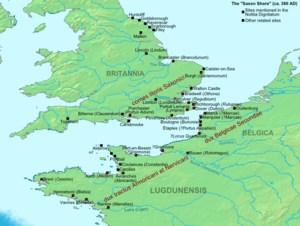Dux Belgicae secundae
| Dux Belgicae secundae | |
|---|---|
 The Saxon Shore (Litus saxonicum) around the year 380. | |
| Active | end of the fourth century to the fifth century |
| Country | Roman Empire |
| Type | commander of a stretch of the Rhine limes and Litus Saxonicum (Saxon Shore) |

The Dux Belgicae secundae (literally "commander of the second Belgic province") was a senior officer in the late Roman army of the West, Supreme Commander of the limitanei and a naval squadron to the so-called Saxon Shore in Gaul.
A known Dux was the Frankish king Childeric I (late 5th century).
Definition
The Office was probably established around 395 AD. At the imperial court the Dux counted to the highest ranking class of viri spectabiles. In the Notitia Dignitatum be for the Gallic part of the Litus saxonicum two high command units and units for securing the coasts of Flanders (Belgica II), of Normandy (province Lugdunensis II) and of Brittany (province Lugdunensis III) enumerated in the above Commander and the adjacent tract Dux Armoricani et Nervicani. These two section commanders were probably the successors of a public official, who formerly held the command over both the British and on the Gallic part of the Saxon Shore (Comes maritimi). Their coastal defense was maintained up to the mid-5th Century.
In the final phase of Roman rule over Gaul acted the commander of the Salian Franks, Childeric, as a civilian administrator and commander of the warrior groups on the territory around the town of Tournai in the north of the province. The city served as his residence and administrative headquarter. His power was based, inter alia, to also resident here armament workshops. It is unclear whether Childerich (rex) even as Roman general or already own as king acted; most likely were both offices then merged with each other already. Childerich but felt probably especially true of late Roman committed military aristocracy of Gaul. This combination of civilian and military powers can a prominent position in the Reich Administration Childerich guess. Perhaps he has been confirmed by a high Roman dignitary in his office. It is believed that he as Dux before the other barbarisn commander ranked. In his - 1653 discovered - grave mound was found among other things. Byzantine gold coins, a brocade coat (paludamentum) and a golden clasp to close the coat. The former have been interpreted in the research as wages for work done military service, the latter as rank insignia of late Roman army.
Forts, officers and units

XXXVIII. Dux Belgicae secundae.
Sub dispositione viri spectabilis ducis Balgicae secundae :
Equites Dalmatae, Marcis in litore Saxonico.
Praefectus classis Sambricae, in loco Quartensi siue Hornensi.
Tribunus militum Neruiorum, Portu Epatiaci.
Officium autem habet idem uir spectabilis dux hoc modo :
Principem xe eodem corpore.
Numerarium.
Commentariensem.
Adiutorem.
Subadiuuam.
Regrendarium.
Exceptores.
Singulares et reliquos officiales[1]
In addition to administrative staff (officium) were still eight tribunes / prefects and their units available to this Dux (sub dispositione):
- Equites Dalmatae (no officer stated).
- Praefectus classis Sambricae, commander of a flotilla of patrol ships (Navis lusoria), the fourth since the Century on the Somme was stationed. Their bases were in locus Quartensis or Vicus ad Quantiam (Port d'Etaples, France, north of the Somme estuary) and locus Hornensis (possibly Cap Hornu, Saint-Valery-sur-Somme, France).
Tribunus militum Nerviorum, a prefect for Sarmatian settlers: Praefectus Sarmatarum gentilium, inter Renos et Tambianos secundae provinciae Belgicae, and four prefects, that commanded the contingents of Germanic Laeti:
- Praefectus laetorum Nerviorum in Fanomantis (modern Famars, Picardie, France),
- Praefectus laetorum Batavorum Nemetacensium in Atrabatis (modern Arras, Pas de Calais, France),
- Praefectus laetorum Batavorum Contraginnensium in Noviomago and a
- Praefectus laetorum gentilium in Remo et Silvanectas.
Their shield emblems are not shown in the Notitia, however.
The Dux had in earlier times, however, more units, that have united under his command. Arnold Hugh Martin Jones identified the origin of, inter alia, units from the Gallic army. They originally came also from the Belgica II and their names are the same as the well-known cities of this province:
- Geminiacenses, a legio comitatenses from Geminiacum (modern Liberchies, Hainaut, Belgium),
- Cotoriacenses, a legio comitatenses from Cotoriacum,
- Prima Flavia (Prima Flavia Metis), a pseudocomitatenses from Metis.
Unlike vexillations of other Duces, these units are no longer indicated standing additionally under the command of the Dux Belgicae II. It seems that this province after the destruction of the border units on the Rhine (Rhine crossing of 406 AD) had to relinquish, one of the first many of their units to the field army.
See also
References
- Notitia Dignitatum Occ. XXXVIII
- Notitia Dignitatum Occ. XXXVII
- Stephen Johnson: The Roman Forts of the Saxon Shore, 1976 JC man, in VA Maxfield (Eds.): The Saxon Shore, 1989, pp. 45-77.
- Hans DL quadrangle: The Roman fleet, Classis Romana. Koehler Verlagsgesellschaft mbH, Hamburg 1996, p. 258 ISBN 3-930656-33-7.
- Insignia viri illustris magistri peditum, Occ. V
Literature
- Arnold Hugh Martin Jones : The Later Roman Empire, 284-602. A Social, Economic and Administrative Survey. 2 vols. Johns Hopkins University Press, Baltimore, 1986, ISBN 0-8018-3285-3 (paperback edition).
- Heinrich Beck and others (eds): Lexicon of Germanic archeology. Volume 18 de Gruyter, Berlin-New York 2001, ISBN 3-11-016950-9, p. 524
- Dieter Geuenich (ed.): The Franks and the Alemanni to the "Battle of Zuelpich" (496/97). Walter de Gruyter, Berlin 1998, ISBN 3-11-015826-4, p. 97
- Stefanie Dick: Königtum, Barbaren auf dem Thron in: Spektrum der Wissenschaft Spezial/Archäologie - Geschichte - Kultur, Nr. 1/2015, p. 29-30.
- Eugen Ewig: Die Merowinger und das Frankenreich, 5. aktualisierte Auflage, Stuttgart 2006, p. 17.